Minor dents and dings are a common issue for vehicle owners, often resulting from everyday occurrences like parking lot mishaps, road debris, or minor collisions. While these small imperfections may seem like mere cosmetic issues, ignoring them can lead to significant long-term consequences. This article explores the hidden costs of neglecting minor dents and dings, highlighting how they can impact your vehicle’s value, safety, and overall longevity. It also emphasizes the importance of timely repairs, particularly using Paintless Dent Repair (PDR), to address these issues effectively.
The Impact on Vehicle Value
Resale Value: One of the most immediate and significant impacts of ignoring minor dents and dings is on the resale value of your vehicle. Potential buyers are likely to perceive a vehicle with visible dents and dings as poorly maintained, which can lead to lower offers or prolonged selling times. Even minor imperfections can detract from the overall appearance of the car, making it less appealing in a competitive market.
Trade-In Value: Similarly, when trading in a vehicle, dealers will assess its condition and use any visible damage as a bargaining tool to lower the trade-in value. While a few minor dents might not seem significant, they can collectively reduce the perceived value of the vehicle. This reduction can amount to hundreds or even thousands of dollars, depending on the make and model of the car.
Appraisal for Loans or Insurance: When seeking an auto loan or insurance coverage, the vehicle’s condition plays a crucial role in the appraisal process. Minor dents and dings can result in lower appraisals, affecting the amount you can borrow or the insurance premiums you pay. Maintaining your vehicle’s exterior in top condition helps ensure you receive the best possible appraisals and rates.
The Risk of Rust and Corrosion
Exposure to Elements: Dents and dings can compromise the protective paint layer on your vehicle, exposing the underlying metal to the elements. This exposure can lead to oxidation, resulting in rust and corrosion. Once rust sets in, it can spread quickly, further damaging the vehicle’s body and potentially compromising its structural integrity.
Long-Term Damage: Rust is not just a cosmetic issue; it can weaken the metal, leading to holes and structural weaknesses. Over time, this can result in costly repairs, such as replacing entire panels or structural components. Addressing minor dents and dings promptly can prevent rust from taking hold and causing extensive damage.
Impact on Paintwork: Even if a dent does not immediately result in rust, it can still affect the surrounding paintwork. The dented area is more susceptible to chipping and peeling, which can further expose the metal and exacerbate the risk of rust. Maintaining the integrity of your vehicle’s paintwork is essential for protecting it from the elements.
Safety Concerns
Compromised Structural Integrity: While minor dents may not seem to affect the safety of your vehicle, they can have a cumulative impact over time. Multiple dents in critical areas, such as the doors or fenders, can weaken the vehicle’s overall structure. In the event of a more serious collision, these weakened areas may not provide the same level of protection, increasing the risk of injury.
Impaired Functionality: Dents and dings can also impact the functionality of your vehicle. For example, a dented door may not close properly, or a dinged fender could interfere with the operation of your vehicle’s lights. These issues can affect your vehicle’s performance and safety, making it essential to address even minor damage promptly.
Increased Repair Costs Over Time
Escalating Damage: Ignoring minor dents and dings can lead to escalating damage over time. What starts as a small, inexpensive repair can become a major issue if left unattended. For example, a minor dent that could be easily fixed with PDR may require extensive bodywork and repainting if rust sets in or if the dent spreads.
Higher Repair Bills: The cost of repairing dents and dings increases significantly once rust or corrosion is involved. Rust removal and repainting are more labor-intensive and expensive than simple dent repairs. By addressing minor dents promptly, you can avoid these higher repair bills and keep your maintenance costs under control.
Preventive Maintenance: Regularly inspecting your vehicle for minor damage and addressing it promptly is a form of preventive maintenance. Just as you would perform routine oil changes and tire rotations to keep your vehicle running smoothly, addressing dents and dings helps maintain the overall health and appearance of your car.
The Benefits of Paintless Dent Repair (PDR)
Cost-Effective Solution: PDR is a highly cost-effective solution for repairing minor dents and dings. The process involves using specialized tools to gently massage the dented metal back into its original shape from behind the panel, preserving the original paintwork. This technique eliminates the need for costly fillers and repainting, making it an affordable option for vehicle owners.
Quick Turnaround: One of the significant advantages of PDR is its quick turnaround time. Many PDR repairs can be completed within a few hours, allowing you to get back on the road with minimal disruption. This efficiency makes PDR an attractive option for busy vehicle owners who need prompt repairs.
Maintaining Original Paint: PDR preserves the original paint, which is crucial for maintaining your vehicle’s value and appearance. Traditional dent repair methods involve sanding, filling, and repainting, which can affect the vehicle’s factory finish. PDR, on the other hand, maintains the integrity of the original paint, ensuring your vehicle looks as good as new.
Environmentally Friendly: PDR is an environmentally friendly repair method, as it does not involve the use of chemical fillers or paints. This reduction in VOC emissions and waste makes PDR a greener choice for vehicle repairs. By choosing PDR, you can minimize your environmental footprint while maintaining your vehicle’s appearance.
Conclusion
Ignoring minor dents and dings can lead to significant hidden costs, including reduced vehicle value, increased risk of rust and corrosion, compromised safety, and higher repair bills over time. Addressing these issues promptly using Paintless Dent Repair (PDR) offers a cost-effective, efficient, and environmentally friendly solution. By taking proactive steps to repair minor damage, you can maintain your vehicle’s appearance, value, and safety, ensuring it remains in top condition for years to come. Remember, a small dent today can become a big problem tomorrow, so don’t delay in getting those minor repairs done.




